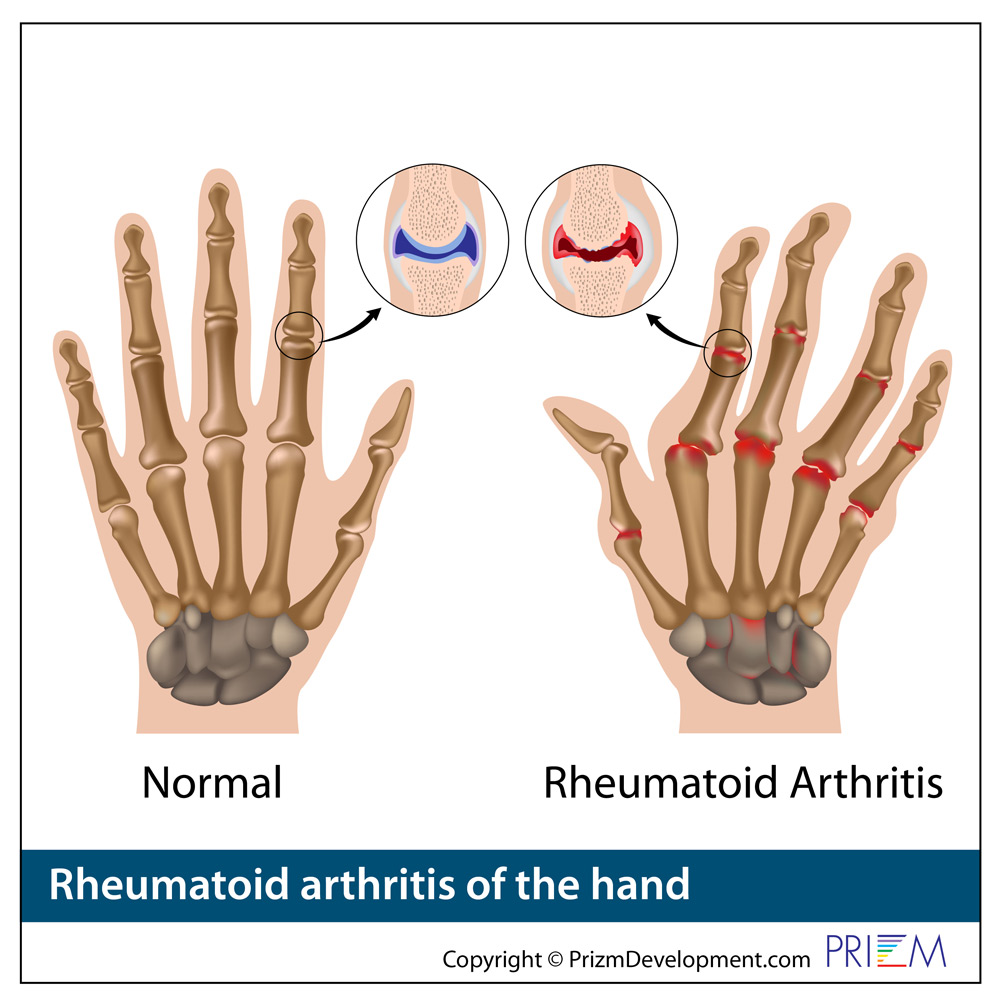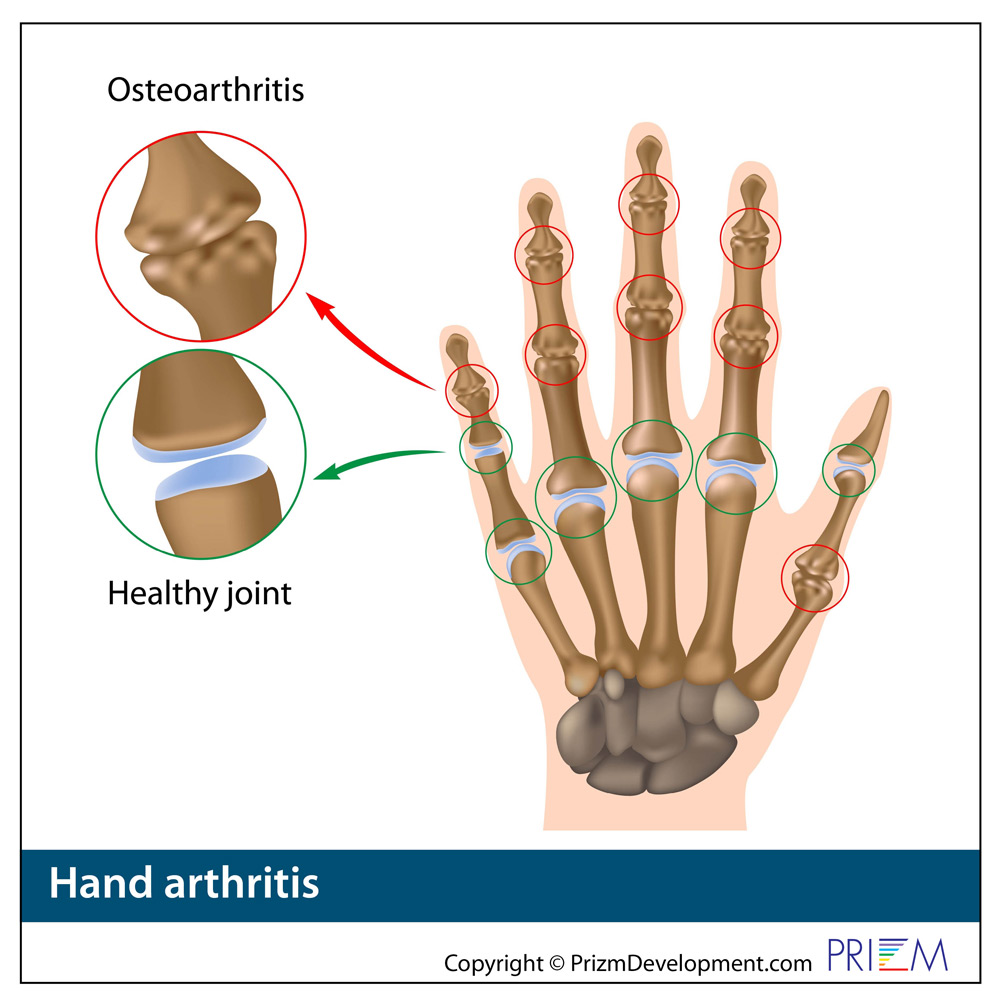Arthritis of the Hand and Wrist
 Arthritis of the Hand and Wrist
Arthritis of the Hand and Wrist
The hand and wrist have multiple small joints that work together, producing motion. This gives us the fine motor skills needed to thread a needle or tie a shoelace. When the joints are affected by arthritis, activities of daily living can be difficult. Arthritis can occur in multiple areas of the hand and wrist and can have multiple causes.
Symptoms
-
Pain: Early symptoms of arthritis of the hand include joint pain that may feel “dull” or like a “burning” sensation. The pain often occurs after periods of increased joint use, such as heavy gripping or grasping.
-
Swelling: When the affected joint is subject to greater stress than it can bear, it may swell in an attempt to prevent further joint use.
-
Changes in Surrounding Joints: In patients with advanced arthritis in the thumb base, the neighboring joints may become more mobile than normal.
-
Warmth: The arthritic joint may feel warm to the touch. This is due to the body's inflammatory response.
-
Crepitation and Looseness: There may be a sensation of grating or grinding in the affected joint, known as crepitation. This is caused by damaged cartilage rubbing against each other. If arthritis is due to damaged ligaments, the support structures of the joint may be unstable or “loose.”
-
Cysts: When arthritis affects the end joints of the fingers (DIP joints), small cysts, called mucous cysts, may develop. The cysts can cause ridging or dents in the nail plate of the affected finger.
Causes
All arthritic joints lose cartilage, either due to wear, disease or trauma. As the body attempts to make up for the lost cartilage, it produces fluid in the joint lining (synovium), which tries to act like a cushion. This in turn causes the joint to swell and restricts motion. The swelling causes stretching of the joint covering (capsule), which causes pain.
When arthritis occurs due to disease, the onset of symptoms is gradual as the cartilage slowly decreases. The two most common forms of arthritis from disease are osteoarthritis and rheumatoid arthritis. Osteoarthritis is much more common and generally affects older people. It appears in a predictable pattern in certain joints. Rheumatoid arthritis has other system-wide symptoms and may be passed from parent to child (genetically).
When arthritis is due to trauma, the cartilage is damaged. People of any age can be affected. Fractures, particularly those that damage the joint surface in the hand, and dislocations are the most common injuries that lead to arthritis.
Treatment Options
Treatment options for arthritis of the hand and wrist include medication, splinting, injections, and surgery. Your Celebration Orthopaedics hand surgeon will review the best treatment option for your condition based on the following critera:
- How far has the arthritis has progressed
- How many joints are involved
- Your age, activity level and other medical conditions
- If the dominant or non-dominant hand is affected
- Your personal goals, home support structure, and ability to comply with a therapy program
Medications
Medications treat symptoms but cannot restore joint cartilage or reverse joint damage. The most common medications for arthritis are anti-inflammatories, which stop the body from producing chemicals that cause joint swelling and pain.
Injections
When first-line treatment with anti-inflammatory medication is not appropriate, injections may be used. These typically contain a long-acting anesthetic, similar to novacaine but longer lasting, and a steroid that can provide pain relief for weeks to months. The injections can be repeated, but only a limited number of times, due to possible side effects, such as lightening of the skin, weakening of the tendons and ligaments and infection.
 Splinting
Splinting
Injections are usually combined with splinting of the affected joint. The splint helps support the affected joint to ease the stress placed on it by activities. Splints are typically worn during periods when the joints hurt. They should be small enough to allow functional use of the hand when worn.
If nonsurgical treatment fails to provide relief, surgery will be discussed. There are many surgical options available, your Celebration Orthopaedics hand surgeon will select the option that has a reasonable chance of providing long-term pain relief and a return to function. It will be tailored to your individual needs.
If there is any way the joint can be preserved or reconstructed, then a thumb base fusion using a plate and screws is usually chosen. When the damage has progressed to a point that the surfaces will no longer work, a joint replacement or a fusion (arthrodesis) is the best option.
Joint replacement attempts to provide pain relief and functional joint motion. As with hip and knee replacements, there have been significant improvements in joint replacements in the hand and wrist. The goal is to improve the function and longevity of the replaced joint. Most of the major joints of the hand and wrist can be replaced.
Recovery
After any type of joint reconstruction surgery, there is a period of recovery. Often, you will be referred to our Occupational Therapy Department, which can help you maximize your recovery. You may need to use a postoperative splint or cast for a while after surgery to protect the hand while it heals.
During this postoperative period, you may need to modify activities to allow the joint reconstruction heal properly. Typically, pain medication taken by mouth is also used to reduce discomfort.
Length of recovery time varies widely and depends on the extent of the surgery performed and multiple individual factors. However, people usually can return to most, if not all, of their desired activities in about three months after most major joint reconstructions.

 Arm & Hand
Arm & Hand
 Arm & Hand
Arm & Hand